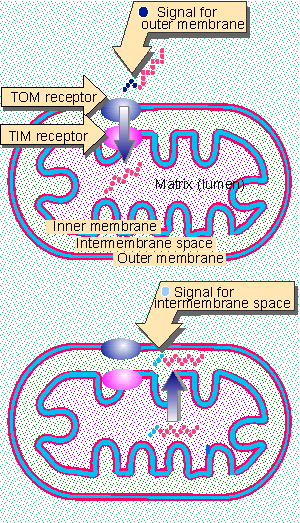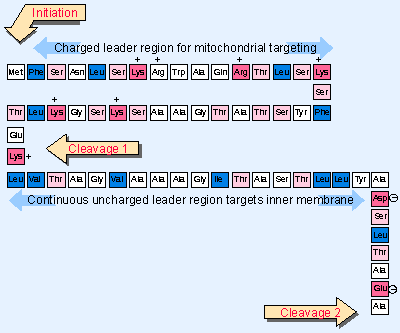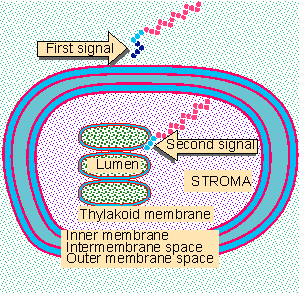6. A hierarchy of sequences determines location within organelles
8.6 A hierarchy of sequences determines location within organelles |
The mitochondrion is surrounded by an envelope consisting of two membranes. Proteins imported into mitochondria may be located in the outer membrane, the intermembrane space, the inner membrane, or the matrix. A protein that is a component of one of the membranes may be oriented so that it faces one side or the other.
 |
Figure 8.17 Mitochondria have receptors for protein transport in the outer and inner membranes. Recognition at the outer membrane may lead to transport through both receptors into the matrix, where the leader is cleaved. If it has a membrane-targeting signal, it may be re-exported. |
What is responsible for directing a mitochondrial protein to the appropriate compartment? The "default" pathway for a protein imported into a mitochondrion is to move through both membranes into the matrix. This property is conferred by the N-terminal part of the leader sequence. A protein that is localized within the intermembrane space or in the inner membrane itself requires an additional signal, which specifies its destination within the organelle. A multipart leader contains signals that function in a hierarchical manner, as summarized in Figure 8.17. The first part of the leader targets the protein to the organelle, and the second part is required if its destination is elsewhere than the matrix. The two parts of the leader are removed by successive cleavages.
Cytochrome c1 is an example. It is bound to the inner membrane and faces the intermembrane space. Its leader sequence consists of 61 amino acids, and can be divided into regions with different functions. The sequence of the first 32 amino acids alone, or even the N-terminal half of this region, can transport DHFR all the way into the matrix. So the first part of the leader sequence (32 N-terminal amino acids) comprises a matrix-targeting signal. But the intact leader transports an attached sequence Xsuch as murine DHFR Xinto the intermembrane space.
What prevents the protein from proceeding past the intermembrane space when it has an intact leader? The region following the matrix-targeting signal (comprising 19 amino acids of the leader) provides another signal that localizes the protein at the inner membrane or within the intermembrane space. For working purposes, we call this the membrane-targeting signal.
Cleavage of the matrix-targeting signal is the sole processing event required for proteins that reside in the matrix. This signal must also be cleaved from proteins that reside in the intermembrane space; but following this cleavage, the membrane-targeting signal (which is now the N-terminal sequence of the protein) directs the protein to its destination in the outer membrane, intermembrane space, or inner membrane. Then it in turn is cleaved.
The N-terminal matrix-targeting signal functions in the same manner for all mitochondrial proteins. Its recognition by a receptor on the outer membrane leads to transport through the two membranes. And the same protease is involved in cleaving the matrix-targeting signal, irrespective of the final destination of the protein. This protease is a water soluble, Mg2+-dependent enzyme that is located in the matrix. So the N-terminal sequence must reach the matrix, even if the protein ultimately will reside in the intermembrane space.
Residence in the matrix occurs in the absence of any other signal. If there is a membrane-targeting signal, however, it is activated by cleavage of the matrix-targeting signal. Then the remaining part of the leader (which is now N-terminal) causes the protein to take up its final destination.
The nature of the membrane-targeting signal is controversial. One model holds that the entire protein enters the matrix, after which the membrane-targeting signal causes it to be re-exported into or through the inner membrane. An alternative model proposes that the membrane-targeting sequence simply prevents the rest of the protein from following the leader through the inner membrane into the matrix. Whichever model applies, another protease (located within the intermembrane space) completes the removal of leader sequences (van Loon et al., 1986; Hartl et al., 1988).
 |
Figure 8.18 The leader of yeast cytochrome c1 contains an N-terminal region that targets the protein to the mitochondrion, followed by a region that targets the (cleaved) protein to the inner membrane. The leader is removed by two cleavage events. |
The two parts of a leader that contains both types of signal have different compositions. As indicated in Figure 8.18, the 35 N-terminal amino acids resemble other organelle leader sequences in the high content of uncharged amino acids, punctuated by basic amino acids. The next 19 amino acids, however, comprise an uninterrupted stretch of uncharged amino acids, long enough to span a lipid bilayer. This sequence resembles the sequences that are involved in protein translocation into membranes of the endoplasmic reticulum (see later).
 |
Figure 8.19 A protein approaches the chloroplast from the cytosol with a ~50 residue leader. The N-terminal half of the leader sponsors passage into the envelope or through it into the stroma. Cleavage occurs during envelope |
Passage through chloroplast membranes is achieved in a similar manner. Figure 8.19 illustrates the variety of locations for chloroplast proteins. They pass the outer and inner membranes of the envelope into the stroma, a process involving the same types of passage as into the mitochondrial matrix. But some proteins are transported yet further, across the stacks of the thylakoid membrane into the lumen. Proteins destined for the thylakoid membrane or lumen must cross the stroma en route.
Chloroplast targeting signals resemble mitochondrial targeting signals. The leader consists of ~50 amino acids, and the N-terminal half is needed to recognize the chloroplast envelope. A cleavage between positions 20-25 occurs during or following passage across the envelope, and proteins destined for the thylakoid membrane or lumen have a new N-terminal leader that guides recognition of the thylakoid membrane. There are several (at least four) different systems in the chloroplast that catalyze import of proteins into the thylakoid membrane (for review see Cline and Henry, 1996).
The general principle governing protein transport into mitochondria and chloroplasts therefore is that the N-terminal part of the leader targets a protein to the organelle matrix, and an additional sequence (within the leader) is needed to localize the protein at the outer membrane, intermembrane space, or inner membrane.
Another example of targeting by means of specific amino acid sequences utilizes C-terminal regions. Peroxisomes are small bodies enclosed by a single membrane. They contain enzymes concerned with oxygen utilization. They convert oxygen to hydrogen peroxide by removing hydrogen atoms from substrates. Catalase then uses the hydrogen peroxide to oxidize a variety of other substrates. All of the enzymes in the peroxisome are imported from the cytosol. Like transport into the nucleus, transport into peroxisomes occurs post-translationally by means of a short sequence. Several peroxisomal enzymes have the C-terminal sequence SKL (Ser-Lys-Leu); and the addition of this tripeptide to the C-terminus of cytosolic proteins is sufficient to ensure their import into the organelle. This very short sequence therefore constitutes one means of entry; there are others.
| Reviews | |
| Cline, K. and Henry, R. (1996). Import and routing of nucleus-encoded chloroplast proteins. Ann. Rev. Cell Dev. Biol. 12, 1-26. | |
| Research | |
| Hartl, F.-U. et al. (1988). Successive translocation into and out of the mitochondrial matrix: targeting of proteins to the intermembrane space by a bipartite signal peptide. Cell 51, 1027-1037. | |
| van Loon, A. P. G. M. et al. (1986). The presequences of two imported mitochondrial proteins contain information for intracellular and intramitochondrial sorting. Cell 44, 801-812. | |